

IntoMobile. Conferencing company iVisit is showing off an interesting technology that uses mobile phones to help visually challenged users.

Using the so called SeeScan, users can point their mobile phones at an object and have it identified in real-time. Think of it as Nokia Point & Find sort of technology. For instance, you can point your device to a bottle of Coke and the software will read loud that is’t the Coke you’re watching. At the moment, software works with packaged goods, only, but it’s a solid start, nonetheless. We’ve no doubts iVisit, Nokia and other companies will keep developing similar, augmented reality apps in the future. According to iVisit, there are approximately 11.4 million people with vision loss in the U.S., 10% of whom are legally blind. On Google Glass: It's Not Augmented Reality. Photo by The Verge.
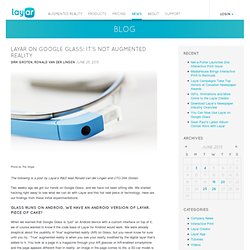
The following is a post by Layar’s R&D lead Ronald van der Lingen and CTO Dirk Groten. Two weeks ago we got our hands on Google Glass, and we have not been sitting idle. Augmented Reality. Visionovation (UPDATE) - Inventions helping the visually impaired navigate the world around them. GPS for the visually impaired. Since the Global Positioning System (GPS) was introduced in the late 1980s there have been many attempts to integrate it into a navigation-assistance system for blind and visually impaired people.

Software Solutions[edit] Symbian OS[edit] Loadstone GPS[edit] The Loadstone project is developing an open source software for satellite navigation for blind and visually impaired users. The software is free and runs currently on many different Nokia devices with the S60 platform under all versions of the Symbian operating system. The Loadstone developers, who are blind, are from Vancouver, Glasgow, and Amsterdam. Lodestone is the name of a natural magnetic iron that was used throughout history in the manufacturing of compasses. JavaME[edit] LoroDux[edit] LoroDux was a project by Fachhochschule Hannover. Windows Mobile[edit] Mobile Geo[edit] Mobile Geo is Code Factory’s GPS navigation software for Windows Mobile-based Smartphones, Pocket PC phones and personal digital assistants (PDAs). IOS[edit] Tactile Directory for the Visually Impaired.
Haptic Radar Problem/Issue: Most built environments mainly focus on wheelchair accessibility and other limb related disabilities while the visually impaired are rarely on the radar of the designer.
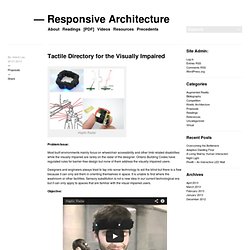
Ontario Building Codes have regulated rules for barrier-free design but none of them address the visually impaired users. Designers and engineers always tried to tap into sonar technology to aid the blind but there is a flaw because it can only aid them in orienting themselves in space. 004586_10. WandererApp. Heare App is now available: Download HEARE app for free.
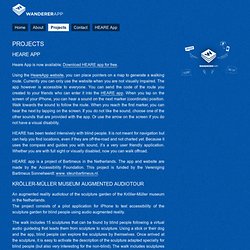
Using the HeareApp website, you can place pointers on a map to generate a walking route. Currently you can only use the website when you are not visually impaired. The app however is accessible to everyone. ProjectDwarf. DWARF is a CORBA based framework that allows the rapid prototyping of distributed Augmented Reality applications.
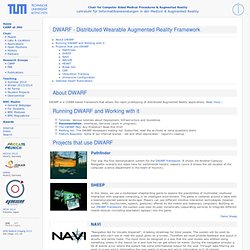
Read more... Tutorials: Various tutorials about Deployment, Infrastructure and Guidelines Documentation: Interfaces, Services (work in progress) The DWARF FAQ: Any Problems? The OrCam: A Portable, Wearable Visual System for Blind and Visually Impaired Persons - VisionAware. OrCam is an Israeli start-up company, founded in 2010 by Amnon Shashua, Sachs Professor of Computer Science at The Hebrew University of Jerusalem.

The mission of OrCam is to develop a "portable, wearable visual system with 'human-like' capabilities" for blind and visually impaired persons, via the use of artificial computer intelligence and augmented reality. The OrCam (pictured at left) is based on computer algorithms that Professor Shashua has pioneered with Shai Shalev-Shwartz, a Hebrew University colleague, and Yonatan Wexler, their former graduate student, who is OrCam's head of Research and Development.
OrCam also has assembled a team of experienced engineers, most of whom are from elite technological units of the Israel Defense Forces and academia. M.good. Most of us take our mobility for granted.
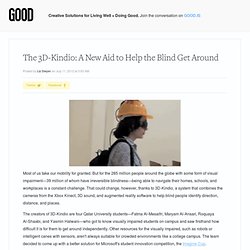
But for the 285 million people around the globe with some form of visual impairment—39 million of whom have irreversible blindness—being able to navigate their homes, schools, and workplaces is a constant challenge. That could change, however, thanks to 3D-Kindio, a system that combines the cameras from the Xbox Kinect, 3D sound, and augmented reality software to help blind people identify direction, distance, and places.
DanKam: Augmented Reality For Color Blindness. [And, we're in Forbes!]

[DanKam vs. A Really Epic Optical Illusion] [CNet] So, for the past year or so, I’ve had a secret side project. Technically, that shouldn’t be surprising. This is security. Except my side project has had nothing to do with DNS, or the the web, or TCP/IP. Instead, I’ve been working on correcting color blindness. Will Augmented Reality improve the blind people´s life? - ARLab Blog. When we think on technology from the perspective of people with vision loss, we can think of two main categories: general technology or assistive technology.

While in the former we can think on devices like personal computers, smartphones or a GPS device, in the later we must think on items designed specifically to help people with vision loss or other disabilities, such as devices specifically designed for reading and writing with low vision or even with no vision, or screen readers for blind individuals. Fortunately for countless people with vision impairments, today’s assistive technology for the blind and vision impaired makes writing and reading, in term papers much easier than before. Blind technology also assists the visually impaired with reading books, websites, and email, using appliances, navigating cities and towns, and much more. And it seems that Augmented Reality can have something important to say in order to join to this race. Augmented reality goggles allow people blind in one eye to experienceQR Code Press.
New software that has been implemented into augmented reality goggles that has allowed individuals with one eye to experience depth perception by projecting the additional images for the healthy eye. This provides the wearer of the AR glasses with an enhanced perception of depth. Being able to judge three dimensional distances has, until now, been a capability that has been limited to individuals who have two functioning eyes. This helps people to be able to judge the distance between two objects. Augmented-reality-android-diploma-thesis - Talking Places - Intelligent Representation of Surroundings for Visually Impaired People. Talking Places is an accessible Android application developed by Zdeněk Papež as a diploma thesis at Czech Technical University in Prague in 2011.
The application was designed for visually impaired people, providing them with information in surroundings. The application was successfully tested on blind users. Features uses Android accessibility to provide feedback for visually impaired people provides localized (GPS) about points of interest in the surrounding communicates with OpenStreetMap, Google Maps, Wikipedia and Panoramio to retrieve data enables filtering, sorting filtering by current street includes virtually tactile map of places in an accessible MapView search by name easy to ask for walking directions (uses Gmaps) Install free from Android Market TalkingPlaces - updated (please use this version because I cannot maintain updates on the original release) Download.
ICDVRAT2010_S02_N02_Kirner_etal. Guiding the visually impaired with augmented reality audio. Augmented reality The WAM project team has developed a mobile augmented reality audio application to help guide the visually impaired when using public transport. Do-It-Yourself object identification using augmented reality for visually impaired people.
2011-MOBIQUITOUS. VisionForTheBlind. OrCam's $2,500 augmented reality glasses speak words aloud, help the visually impaired 'see' Katz_bf_12_253. Augmented Reality: What will augmented reality be like for a blind person. Augmented Reality for blind people (AAR) (Page 1) — Visually disabled gamers — Game Accessibility Forum. Kinect to help the blind 'see' in augmented reality. (PhysOrg.com) -- It seems like there are no shortage of uses for the Kinect system. The device, which was initially created by Microsoft as an add-on to its popular Xbox 360 video game console, to allow users to ditch the controller, has been getting around. Now, it has been integrated into a system designed to help the blind.
The system in question, which was designed by graduate students at the Universität Konstanz in Germany, has been dubbed the NAVI, or Navigational Aids for the Visually Impaired. NAVI works something like this. The infrared camera from a Kinect system is mounted to a helmet that can be worn by a bilnd person. The goal is to be able to give a blind person warnings about potential obstructions and directions to navigate in set spaces, at a longer distance than the current systems in place. Camera-toting EyeRing could help blind people to "see" objects. Generally speaking, the vast majority of augmented reality applications that enhance the world around us by overlaying digital content on images displayed on smartphone, tablet or computer screens are aimed squarely at the sighted user. A team from the Fluid Interfaces Group at MIT's Media Lab has developed a chunky finger-worn device called EyeRing that translates images of objects captured through a camera lens into aural feedback to aid the blind.
The EyeRing system was created by Suranga Nanayakkara (who currently directs the Augmented Senses Research Group at Singapore University of Technology and Design), PhD student Roy Shilkrot and associate professor and founder of the Fluid Interfaces Group, Pattie Maes. It features a 3D-printed ABS nylon outer housing containing a small VGA camera unit, a 16 MHz AVR processor, a Bluetooth radio module and a 3.7V Li-ion battery. Other applications for the system include cane-free navigation. Source: MIT.